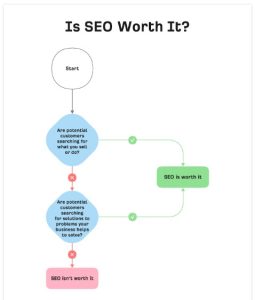- Home
- SEO Strategies
- Is SEO Worth It? Discover the...

In accordance with HubSpot’s insights, a substantial 69% of marketers actively allocate resources to SEO endeavors. However, the crux of the matter lies in determining whether SEO is a judicious investment of time and resources for your unique situation. Seeking a direct response to this query? Engage with this flowchart for clarity:
Step 1: If the response to both queries is affirmative, then SEO likely holds value for you. This is because SEO significantly enhances the likelihood of securing high rankings for pertinent search inquiries, ushering in a consistent flow of qualified traffic without the need for financial outlays.

Step 2: Conversely, an alternative marketing strategy might be more advantageous if the response to all queries is negative. In need of guidance for responding to these questions? Delve into further insights below.
For local businesses, the answer is typically a resounding “yes.” Statistics underscore this:
In essence, neglecting pertinent local queries could translate to lost revenue. This is where local SEO takes the reins. However, for e-commerce, SaaS, or smaller online enterprises, the narrative might differ, particularly if the offerings are novel or niche.
Considerations are different for companies like Kohler, pioneers of smart bathing systems. Navigating through this uncharted territory necessitates diversified marketing strategies. As of now, the market is still warming up to this novel technology. (Data from Ahrefs’ keyword generator)
Also Read-Achieving Remarkable Sales Growth
The initial step involves plugging your offerings into a keyword research tool to gauge search volume. For instance, using Ahrefs’ free keyword generator reveals that the term “commissary kitchen” garners an estimated 5,900 monthly searches in the U.S. alone. Thus, it is evident that people are indeed searching for such services.
However, even if the answer is not affirmative, your individual products or services might still attract searches. Examining these using a keyword tool to ascertain the level of interest is worthwhile. Should this also be unpromising, fret not, as SEO might still hold potential. This leads us to the second question.
Even when direct searches for your products or services are scant, people could be scouring for solutions that your business can provide. This is highly likely considering:
A prime example is our Content Explorer tool, scarcely searched directly on Google. However, individuals search for solutions it facilitates, such as link prospecting or content idea generation.
SEO retains its significance in this context, enabling you to create content that guides searchers in solving their problems using your offerings. Our approach at Ahrefs revolves around this principle.
To evaluate whether searchers are seeking solutions your business can provide, employ a keyword research tool as executed in the first question. Input the issue your product/service addresses, and explore the Questions tab for relevant queries.
For instance, a new relaxation program/product with a unique name might lack search volume. However, the issue of ineffective relaxation still garners attention. Creating content addressing relaxation queries can thus generate awareness for this novel program.
Once you’ve affirmed the viability of SEO based on responses to questions #1 and/or #2, it’s vital to consider whether the cost and effort expended would justify the rewards reaped. In essence, you have three primary avenues for investing in SEO:
A potential fourth “hybrid” option entails initially engaging an agency or freelancer to witness outcomes. Depending on results, you might construct an in-house SEO team or even learn SEO yourself.
Notably, we surveyed professionals within the SEO industry to glean insights into their service charges and pricing models. If you opt for hiring an agency or consultant, seek their expert opinion on the worthiness of SEO for your specific case. A reputable agency will furnish an honest assessment, substantiating their stance.
If you’re inclined towards a DIY approach or intend to enlist assistance, understanding SEO’s mechanics and conducting meticulous keyword research are paramount. Generally, the higher the search volume for a keyword, the more competitive and challenging it becomes to attain a ranking. Consequently, newcomers to the SEO realm often find it judicious to focus on low-competition keywords at the outset, provided they remain relevant to their business.
The necessity of food for dogs is universally known. Yet, queries regarding sharing bananas with dogs and the concept of human-grade and air-dried dog food underscore evolving consumer interests. This data aligns with keyword ranking difficulties (KD), with the second keyword posing medium difficulty, while the latter two offer relatively simpler rankings.
Should you aspire to deepen your comprehension of SEO for confident decision-making, explore our free learning resources:
If your aspiration is to elevate your business via SEO, the foremost consideration is to ascertain if search queries about your offerings manifest any demand. In essence, SEO channels a fraction of this search demand toward your website. Finally, recognize that this article offers a concise response, representing the first step in your SEO journey—an invitation to devise a tailored SEO strategy, either independently or through a professional’s guidance. For any inquiries or feedback, feel free to reach out to me on Twitter.
© 2013 - 2024 Foreignerds. All Rights Reserved